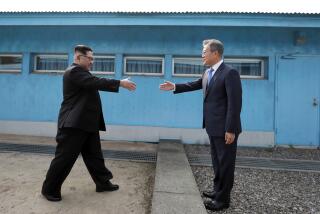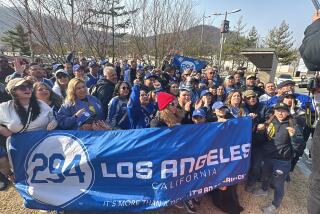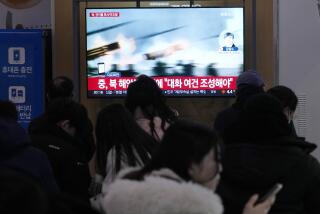A Battle-Ready South Korean Island Feels a Thaw Coming On
PAEKRYONG, South Korea — The thaw in relations between North and South Korea couldn’t be more apparent than here, on this remote, highly fortified South Korean island at the last frontier of the Cold War.
Just 15 months ago, the atmosphere on the island was tense after a bloody naval shootout between the two Koreas in disputed Yellow Sea waters nearby. Over the years, dozens of South Korean fishing boats have vanished from the crab-rich waters--their occupants suspected of being kidnapped by the North.
But then came the historic June summit in which South Korean President Kim Dae Jung and North Korean leader Kim Jong Il exchanged bearhugs and toasts, and agreed to work toward eventual reunification of the peninsula as a loose confederation.
Just as significant for the islanders, however, was a goodwill gesture by the North: It returned a South Korean fishing boat, the Kyolsong Ho, which it had detained for several hours after the boat allegedly crossed into North Korean waters.
Fishermen Gaze North
Now the local civic women’s group, which five years ago decided to learn how to shoot guns and train regularly in case of attack, is finding its exercises less relevant and questioning whether to continue them. The local high school has scaled back the annual military-training exercises for its students. And fishermen--who were forbidden to fish for three weeks after last year’s deadly shootout--are talking of their desire to one day meet their North Korean counterparts, whose boats they can see from afar but with whom they have never had contact.
“I feel the effect of the summit,” fisherman Park Se Bok, 48, said as he sliced frozen fish to load into crab traps on a recent afternoon. “I wish I could have a nice talk with them.”
The frost from the half-century of Cold War on the peninsula has always been felt the most on this island, now home to about 4,400 civilians. North Korea’s craggy southwestern coast is clearly visible from the island, seemingly just a mile or two away, although it is actually about 10 miles. (The closest North Korean island is about seven miles away.) Getting here from the mainland requires a four- to five-hour ferry ride from Inchon, near Seoul.
Despite the seeming calm, however, nothing has changed here from a military point of view, said Gen. Kim Mung Kwun, who leads the South Korean marines on the island.
The military is omnipresent on the island, with hundreds of troops positioned in bunkers along the mountainous coastline. (The U.N. command drew a line known as the Northern Limit Line after the Korean War ended in 1953 without a peace treaty; it juts out to include several islands above the demilitarized zone. North Korea has challenged the line.)
South Korean naval officers conduct exercises several times a month, using rafts and simulating battle. Ten-foot fences topped by barbed wire ring the island, blocking access to most of the coastline.
Civilians, most of whom make their living fishing for crabs and tiny anchovies and other small fish, aren’t allowed on the beachfront facing North Korea. Metal stakes stand in the shallows around most of the island to prevent boats from coming ashore with spies, military personnel or refugees.
One beach that is open to the public is backed by bunkers and empty concrete shelters with holes from which to fire weapons.
The ‘Hawaii of Asia’?
Mayor Cho Gun Ho wants to capitalize on the proximity to the North and the easing of tensions. Tourism has increased sharply already: So far this year, 45,000 South Korean visitors have come, compared with 30,000 last year. The mayor wants to petition the government to allow the twice-daily ferries to take a more direct route. (Because of the military tensions, they now have to head farther west before swinging east.) It could cut as much as an hour off the trip.
He also envisions creating hotels to supplement the island’s few small inns, and promoting it--with its stark rock cliffs and one beach formed of perfectly smooth pebbles of many shapes, sizes and colors--as the “Hawaii of Asia.”
More to Read
Sign up for Essential California
The most important California stories and recommendations in your inbox every morning.
You may occasionally receive promotional content from the Los Angeles Times.










